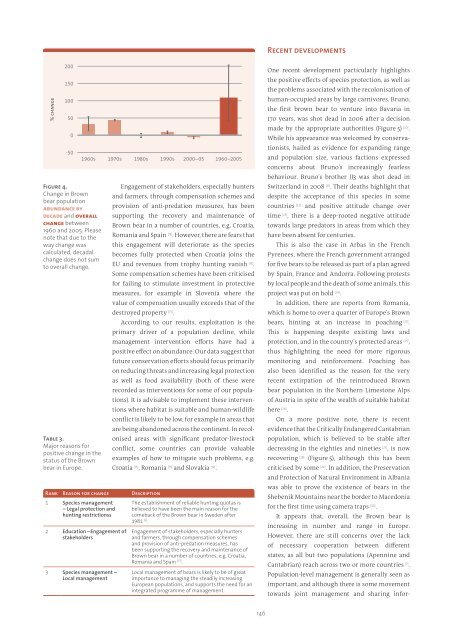130925-studie-wildlife-comeback-in-europe
You also want an ePaper? Increase the reach of your titles
YUMPU automatically turns print PDFs into web optimized ePapers that Google loves.
Recent developments<br />
% change<br />
200<br />
150<br />
100<br />
50<br />
0<br />
-50<br />
Figure 4.<br />
Change <strong>in</strong> Brown<br />
bear population<br />
abundance by<br />
decade and overall<br />
change between<br />
1960 and 2005. Please<br />
note that due to the<br />
way change was<br />
calculated, decadal<br />
change does not sum<br />
to overall change.<br />
Table 3.<br />
Major reasons for<br />
positive change <strong>in</strong> the<br />
status of the Brown<br />
bear <strong>in</strong> Europe.<br />
Rank Reason for change Description<br />
1 Species management<br />
– Legal protection and<br />
hunt<strong>in</strong>g restrictionss<br />
2 Education –Engagement of<br />
stakeholders<br />
3 Species management –<br />
Local management<br />
1960s 1970s 1980s 1990s 2000–05 1960–2005<br />
Engagement of stakeholders, especially hunters<br />
and farmers, through compensation schemes and<br />
provision of anti-predation measures, has been<br />
support<strong>in</strong>g the recovery and ma<strong>in</strong>tenance of<br />
Brown bear <strong>in</strong> a number of countries, e.g. Croatia,<br />
Romania and Spa<strong>in</strong> [13] . However, there are fears that<br />
this engagement will deteriorate as the species<br />
becomes fully protected when Croatia jo<strong>in</strong>s the<br />
EU and revenues from trophy hunt<strong>in</strong>g vanish [13] .<br />
Some compensation schemes have been criticised<br />
for fail<strong>in</strong>g to stimulate <strong>in</strong>vestment <strong>in</strong> protective<br />
measures, for example <strong>in</strong> Slovenia where the<br />
value of compensation usually exceeds that of the<br />
destroyed property [13] .<br />
Accord<strong>in</strong>g to our results, exploitation is the<br />
primary driver of a population decl<strong>in</strong>e, while<br />
management <strong>in</strong>tervention efforts have had a<br />
positive effect on abundance. Our data suggest that<br />
future conservation efforts should focus primarily<br />
on reduc<strong>in</strong>g threats and <strong>in</strong>creas<strong>in</strong>g legal protection<br />
as well as food availability (both of these were<br />
recorded as <strong>in</strong>terventions for some of our populations).<br />
It is advisable to implement these <strong>in</strong>terventions<br />
where habitat is suitable and human-<strong>wildlife</strong><br />
conflict is likely to be low, for example <strong>in</strong> areas that<br />
are be<strong>in</strong>g abandoned across the cont<strong>in</strong>ent. In recolonised<br />
areas with significant predator-livestock<br />
conflict, some countries can provide valuable<br />
examples of how to mitigate such problems, e.g.<br />
Croatia [13] , Romania [13] and Slovakia [19] .<br />
The establishment of reliable hunt<strong>in</strong>g quotas is<br />
believed to have been the ma<strong>in</strong> reason for the<br />
<strong>comeback</strong> of the Brown bear <strong>in</strong> Sweden after<br />
1981 [2] .<br />
Engagement of stakeholders, especially hunters<br />
and farmers, through compensation schemes<br />
and provision of anti-predation measures, has<br />
been support<strong>in</strong>g the recovery and ma<strong>in</strong>tenance of<br />
Brown bear <strong>in</strong> a number of countries, e.g. Croatia,<br />
Romania and Spa<strong>in</strong> [13] .<br />
Local management of bears is likely to be of great<br />
importance to manag<strong>in</strong>g the steadily <strong>in</strong>creas<strong>in</strong>g<br />
European populations, and supports the need for an<br />
<strong>in</strong>tegrated programme of management.<br />
One recent development particularly highlights<br />
the positive effects of species protection, as well as<br />
the problems associated with the recolonisation of<br />
human-occupied areas by large carnivores. Bruno,<br />
the first brown bear to venture <strong>in</strong>to Bavaria <strong>in</strong><br />
170 years, was shot dead <strong>in</strong> 2006 after a decision<br />
made by the appropriate authorities (Figure 5) [20] .<br />
While his appearance was welcomed by conservationists,<br />
hailed as evidence for expand<strong>in</strong>g range<br />
and population size, various factions expressed<br />
concerns about Bruno’s <strong>in</strong>creas<strong>in</strong>gly fearless<br />
behaviour. Bruno’s brother JJ3 was shot dead <strong>in</strong><br />
Switzerland <strong>in</strong> 2008 [21] . Their deaths highlight that<br />
despite the acceptance of this species <strong>in</strong> some<br />
countries [22] and positive attitude change over<br />
time [23] , there is a deep-rooted negative attitude<br />
towards large predators <strong>in</strong> areas from which they<br />
have been absent for centuries.<br />
This is also the case <strong>in</strong> Arbas <strong>in</strong> the French<br />
Pyrenees, where the French government arranged<br />
for five bears to be released as part of a plan agreed<br />
by Spa<strong>in</strong>, France and Andorra. Follow<strong>in</strong>g protests<br />
by local people and the death of some animals, this<br />
project was put on hold [24] .<br />
In addition, there are reports from Romania,<br />
which is home to over a quarter of Europe’s Brown<br />
bears, h<strong>in</strong>t<strong>in</strong>g at an <strong>in</strong>crease <strong>in</strong> poach<strong>in</strong>g [25] .<br />
This is happen<strong>in</strong>g despite exist<strong>in</strong>g laws and<br />
protection, and <strong>in</strong> the country’s protected areas [25] ,<br />
thus highlight<strong>in</strong>g the need for more rigorous<br />
monitor<strong>in</strong>g and re<strong>in</strong>forcement. Poach<strong>in</strong>g has<br />
also been identified as the reason for the very<br />
recent extirpation of the re<strong>in</strong>troduced Brown<br />
bear population <strong>in</strong> the Northern Limestone Alps<br />
of Austria <strong>in</strong> spite of the wealth of suitable habitat<br />
here [26] .<br />
On a more positive note, there is recent<br />
evidence that the Critically Endangered Cantabrian<br />
population, which is believed to be stable after<br />
decreas<strong>in</strong>g <strong>in</strong> the eighties and n<strong>in</strong>eties [27] , is now<br />
recover<strong>in</strong>g [28] (Figure 5), although this has been<br />
criticised by some [29] . In addition, the Preservation<br />
and Protection of Natural Environment <strong>in</strong> Albania<br />
was able to prove the existence of bears <strong>in</strong> the<br />
Shebenik Mounta<strong>in</strong>s near the border to Macedonia<br />
for the first time us<strong>in</strong>g camera traps [30] .<br />
It appears that, overall, the Brown bear is<br />
<strong>in</strong>creas<strong>in</strong>g <strong>in</strong> number and range <strong>in</strong> Europe.<br />
However, there are still concerns over the lack<br />
of necessary cooperation between different<br />
states, as all but two populations (Apenn<strong>in</strong>e and<br />
Cantabrian) reach across two or more countries [7] .<br />
Population-level management is generally seen as<br />
important, and although there is some movement<br />
towards jo<strong>in</strong>t management and shar<strong>in</strong>g <strong>in</strong>for-<br />
146


